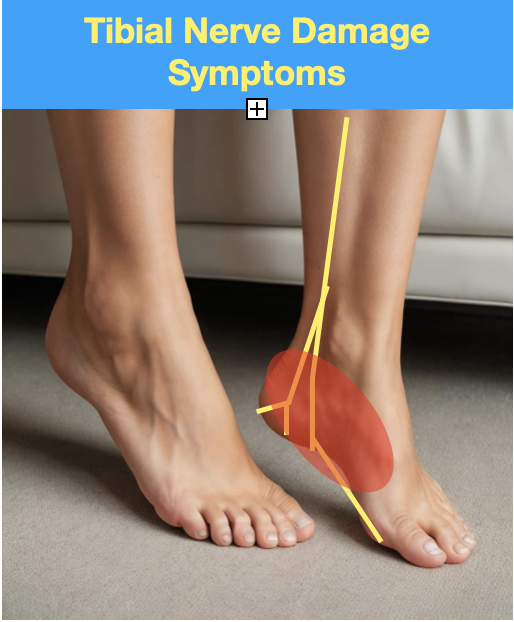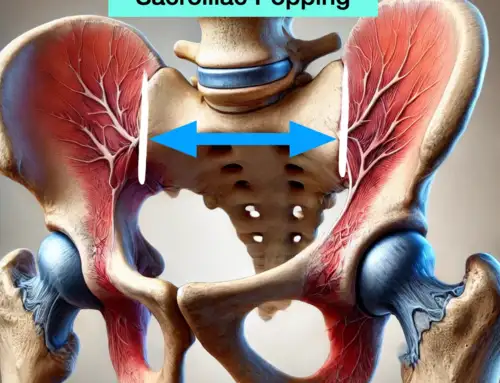Tibial Nerve Damage: Dysfunction, Symptoms and Treatment

Signs of tibial nerve dysfunction or damage can manifest as sensations of numbness, tingling, weakness, or discomfort in the leg and foot. Seeking assistance when encountering these indications is crucial, as unaddressed nerve issues may result in lasting complications.
Welcome to our 2024 updated comprehensive guide on tarsal tunnel syndrome, a condition that affects the tibial nerve as it passes through the narrow space known as the tarsal tunnel. As experts in this field, we provide first-hand knowledge and valuable tips to help you understand and manage this condition effectively.
Other names for this syndrome include:
- TTS (Abbreviation)
- Posterior Tibial Neuralgia
Causes
- Overuse or Repetitive Strain: Activities that involve excessive use of your feet, such as running or standing for extended periods, may increase your risk of developing tarsal tunnel syndrome.
- Ankle Injuries: Previous sprains or fractures in your ankle can lead to inflammation and swelling around the tibial nerve, resulting in compression within the tarsal tunnel.
- Foot Deformities: Structural abnormalities like flat feet or high arches can disrupt weight distribution across your foot, potentially exerting pressure on the nerves within the tarsal tunnel.
- Systemic Conditions: Medical conditions like diabetes, arthritis, obesity, or hypothyroidism have been linked to an increased likelihood of developing neuropathies, including tarsal tunnel syndrome.
Manifestation of tibial nerve injuries can also be a referral from a neuropathy in the lumbar spine by the L4-S3 spinal nerve roots. Should be considered in case of nerve related pain in the ankle, foot and even toes.
Discover the causes and risks of tarsal tunnel syndrome. Empower yourself to make informed lifestyle decisions and seek medical attention.
Symptoms of Dysfunction
When it comes to tarsal tunnel syndrome, understanding the symptoms is critical. Here are some common manifestations of tibial nerve dysfunction:

- Tingling or numbness: One of the most common signs of tarsal tunnel syndrome is a tingling sensation or numbness in your toes, particularly at the bottom of your foot.
- Burning sensation: Some individuals also describe a burning sensation that follows the path of the affected nerve.
- Pain: Tarsal tunnel syndrome can bring about pain in various areas, such as the sole of your foot, heel, arch, or even up into your calf.
- Weakness: In some instances, muscle dysfunction caused by nerve compression may result in weakness.
Symptoms of tarsal tunnel syndrome vary from person to person. Depending on underlying conditions, previous injuries, or unique anatomical variations, they can be more severe or frequent. Early detection is crucial for effective management of any neuropathy. If you suspect you have symptoms, seek professional medical advice immediately.
In some instances, indications of tibial nerve injury are just referral pain from a disc herniation putting pressure or causing an entrapment of the L4-L5 nerve root, which would be technically sciatica. Chronic or failed cases should consider this alternative diagnosis. Signs of tibial nerve impairment that are referred from the lower back have similar symptoms as TTS.
Diagnosis Procedures
To accurately diagnose tarsal tunnel syndrome, specific diagnostic procedures are necessary. These include:
- Thorough Physical Examination: Your doctor will examine your symptoms and medical background. Conduct orthopedic assessments to evaluate the movement and flexibility of your foot and ankle.
- Nerve Conduction Studies (NCS): This test measures how effectively electrical impulses travel along the nerves in your legs and feet.
- Electromyography (EMG): EMG measures muscle activity to determine if any muscle weakness or damage results from nerve dysfunction.
- Imaging Tests: X-rays, ultrasound scans, or magnetic resonance imaging (MRI) may be recommended to rule out other conditions or provide further clarity on structural abnormalities.
- Tennel’s Sign- Tapping on the nerve with a reflex hammer or fingers recreates the symptoms
- Nerve Tension Test- A straight leg raise emphasizing tension on the tibial nerve will recreate symptoms.
Trust qualified healthcare professionals for an accurate diagnosis. Online resources can lead to correct conclusions and timely treatment. Take your time, and get the proper care from experts with knowledge and expertise for practical solutions.
Treatment Options
Treatment, for tarsal tunnel syndrome varies based on how severe and whats causing it.
Be sure to check out the self-help treatments included.
Non-Surgical Treatments
- Rest and Immobilization
- Physical Therapy
- Medications
- Orthotic Devices
- Nerve flossing Exercises
- Treatment of the flexor retinaculum
- Increase big toe extension
- Restoring Dorsiflexion
- Foot rehabilitation exercises
Tibial Nerve Flossing Exercises

- Dorsiflex the painful foot upwards and lock it into place.
- Gentle kick the leg forward until a gentle stretch is felt in the leg, ankle, foot, or even toes; repeat 15 times and check if symptoms have reduced. If so, do 15×5 per day.
Keynote: This is a gentle maneuver. At the first sign of stretch (no pain), immediately return to the start position. Aggressive stretching will very likely make it worse!
Clinical Pearl
Low back evaluation: Many lower extremity complaints are referral pain from irritated nerves in the lower back, causing symptoms of tibial nerve dysfunction.
Surgical Interventions
- Tarsal Tunnel Release Surgery
- Nerve Decompression Surgery
Conservative Therapies
- Acupuncture
- Chiropractic Care
- Physical therapy
Each person’s experience with tarsal tunnel syndrome is unique. It would help if you had a personalized treatment plan that caters to your specific needs to achieve the best results. You can access the most effective treatment options tailored to your circumstances by consulting with a healthcare professional specializing in this condition.
Prevention and Management
Preventing tarsal tunnel syndrome and effectively managing its symptoms are crucial for maintaining foot health. Here are some expert tips:
Prevention
- Maintain proper foot posture
- Choose supportive footwear
- Consider orthotic inserts
- Incorporate regular dynamic stretching, no long sustained holds
- Take breaks during repetitive activities
- Maintain a healthy weight
- Manage underlying health conditions
Management
- Rest and elevate the affected leg/foot when possible
- Apply ice packs to reduce inflammation and swelling (old school and research don’t suggest)
- Take over-the-counter pain relievers as directed
- Consider physical therapy exercises
Prevention and management are the dynamic duo in the battle against tarsal tunnel syndrome. By proactively preventing this condition and effectively managing symptoms, you can live a healthy life while minimizing its impact on your daily activities.
Seeking Professional Help
Regarding tarsal tunnel syndrome, seeking professional medical help is crucial for accurate diagnosis and treatment options. Here’s why:
- Qualified healthcare professionals possess the expertise needed for an accurate diagnosis through specific diagnostic procedures.
- Self-diagnosis based on online resources can lead to incorrect conclusions and delay appropriate treatment.
- Professional medical consultation ensures an accurate diagnosis explicitly tailored to your unique situation.
If you’re feeling symptoms or sensations of tarsal tunnel syndrome, don’t wait. Get professional medical advice immediately for the best treatment options and optimal results.
Dr. Justin Dean is a sports Chiropractor in Los Angeles, CA, who specializes in the entrapment of nerves and has invented treatments to address them. These treatments include the foot and ankle. At the Olympic training center, he specialized in running and gait analysis. His blog contains common healthcare issues such as neuropathy and entrapment syndromes, including all nerves that run down the leg, ankle, feet, and toes.
Reach out to book with Dr. Dean by texting or calling 323-354-6077 or email him at drjustindean@gmail.com
Our editorial process includes evidence-based practices, interventions, and recommendations.
References
Mattos I, Ubillus HA, Campos G, et al. Anatomy of the tibial nerve in relation to the tarsal tunnel: A cadaveric study. Foot Ankle Surg. 2022;28(8):1415-1420. doi:10.1016/j.fas.2022.07.011





